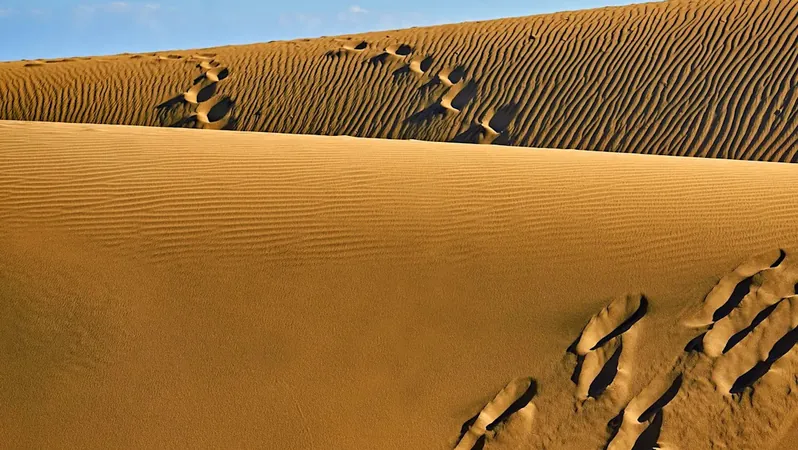
"The Earth Is Tearing Apart": Scientists Sound Alarm Over Indian Plate's Split Beneath Himalayas
2025-09-21
Author: Wei
A Troubling Geophysical Discovery
Beneath the iconic peaks of the Himalayas, an alarming geological event is unfolding. For the past 60 million years, the Indian Plate has been engaging in a slow-motion collision with the Asian continent, giving rise to the world's highest mountain range. But recent studies unveil a far more complex scenario occurring deep below the Earth's crust, with the Indian Plate not merely shifting but actively bending, warping, and even tearing apart.
Understanding the Collision: Not Just a Simple Bump
Geologists have long debated the dynamics of how the Indian Plate interacts with the Eurasian Plate. Traditionally viewed as a gradual push—much like sliding a board under a rug—new seismic research suggests a far more tumultuous relationship. The Indian Plate is fracturing, with sections detaching and molten rock rising through the gaps.
West of 90°E longitude, this tectonic plate operates like a solid mass beneath Tibet. However, to the east, gravity pulls the dense mantle down, leading to gaps where partially molten rock seeps in. This reveals a chaotic and fragmented boundary—a far cry from the neat subduction scientists once imagined.
Revolutionizing Subsurface Mapping
Mapping the complex layers beneath Tibet is no simple task. Conventional seismic methods, which analyze earthquake vibrations to understand subsurface structures, often yield conflicting data, creating disagreements about the Indian Plate's depth and extent—sometimes differing by over 30 miles.
To untangle this mystery, researchers have employed innovative techniques like shear-wave splitting, which examines how seismic waves deform as they travel through stressed rocks. Blending this method with traditional data has led to one of the clearest portrayals yet of the Indian Plate's path.
The Rising Earthquake Threat
The fragmentation of the Indian Plate carries dire consequences. This process, known as delamination, occurs when the lower mantle of the plate peels away, amplifying stress within Earth's crust. Such stress can trigger increasingly powerful and frequent earthquakes in the vulnerable regions of Tibet and the Himalayas. Notably, the Cona-Sangri Rift, a significant fault line, lies precariously above a suspected tear, raising alarms about potential seismic events.
A Urgent Call for Further Research
With millions living near the mighty Himalayas, understanding these geological processes is critical. Scientists, including Fabio Capitanio from Monash University, stress that while this data provides a snapshot, more extensive surveys and chemical analyses are essential to grasp how the Indian Plate continues to change.
A Challenge to Established Beliefs
This research challenges longstanding views on tectonic plate behavior during collisions. Experts like Douwe van Hinsbergen from Utrecht University believe these findings are pivotal, fundamentally reshaping our understanding of continental interactions over geological timescales.
Lessons from Other Mountain Ranges
The insights gleaned from the Indian Plate's behavior extend beyond the Himalayas, potentially explaining the formation of other iconic mountain ranges across the globe, including the Andes and the Rockies. Geologist Peter DeCelles likens the Indian Plate to a manta ray, highlighting how its varied geometry plays a vital role in the ongoing geological drama.
Practical Effects of the Research
The revelation of a tearing Indian Plate has far-reaching implications. It enhances earthquake hazard assessments for millions in Tibet and the Himalayas, where seismic threats loom large. These findings also refine models of mountain formation, shedding light on collision zones worldwide.
By demonstrating the ability of continents to warp and tear, this research transforms our understanding of Earth's remarkable dynamic processes, paving the way for potentially more accurate earthquake predictions that can aid communities in preparing for the natural forces beneath them.
The Path Forward: Unraveling Earth’s Mysteries
As this research continues to evolve, it opens the door to future discoveries that could unravel further mysteries beneath the Earth's surface. The geological activity at the heart of the Indian Plate may lead us to better understand not only our planet’s past but also the seismic challenges that lie ahead.




 Brasil (PT)
Brasil (PT)
 Canada (EN)
Canada (EN)
 Chile (ES)
Chile (ES)
 Česko (CS)
Česko (CS)
 대한민국 (KO)
대한민국 (KO)
 España (ES)
España (ES)
 France (FR)
France (FR)
 Hong Kong (EN)
Hong Kong (EN)
 Italia (IT)
Italia (IT)
 日本 (JA)
日本 (JA)
 Magyarország (HU)
Magyarország (HU)
 Norge (NO)
Norge (NO)
 Polska (PL)
Polska (PL)
 Schweiz (DE)
Schweiz (DE)
 Singapore (EN)
Singapore (EN)
 Sverige (SV)
Sverige (SV)
 Suomi (FI)
Suomi (FI)
 Türkiye (TR)
Türkiye (TR)
 الإمارات العربية المتحدة (AR)
الإمارات العربية المتحدة (AR)